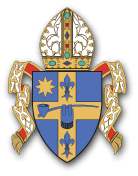Why a Cathedral?
by Bishop Joseph H. Schlarman
Third Bishop of Peoria
No one would wish to see a great state like Illinois without a state house, nor would anyone expect the governor to transact the affairs of state on the sidewalk. And so, too, a Bishop has need of an adequate Chancery office and of a Cathedral that lends itself for the official functions of the Chief Shepherd of the whole flock.
The Cathedral in its representative capacity stands for the whole diocese. It is, in a way, the people’s church. Certain official functions take place normally only in the Cathedral: a diocesan synod, the consecration of holy oils on Maundy Thursday and the other Pontifical functions of Holy Week, the consecration of a Bishop, ordination of priests, the Pontifical High Mass on Pentecost, Christmas, and Easter, and other occasional solemn functions. There is, therefore, such a thing as a Cathedral idea. It is not that the priests and faithful disbelieve this Cathedral idea, but rather that it has not been consistently expressed. The Cathedral is the visible expression of spiritual and organic diocesan life.
Even if we cleanse our hearts and minds from all ambitions of greatness, it may still be assumed that the representative church of the diocese and the Cathedral should by its architecture, decorations, art glass, organ, and Church music, dignified carrying out of the liturgy of the Church, and so forth, be distinguished, in a modest way, above a parish church.
Through the Peoria Register, the distant and sometimes isolated parishes and scattered Catholics have gained by the consciousness that they are a part of the Diocese of Peoria. In a similar manner every parish and every Catholic gains by a representative Cathedral where everything is as it should be and where the Divine services are carried out as they have been handed down through centuries old traditions that link the Church of today with the Church of Apostolic times, when there was a strong consciousness of organic life-all members of the Mystical Body of Christ.
The Cathedral must be a source of inspiration to all. Immediately before the Agnus Dei of the Mass, the priest breaks the Sacred Host into two equal parts, one of which he places on the paten. From the other he breaks a small particle with which he makes the triple Sign of the Cross over the chalice while saying: Pax Domini, sit semper vobicscum May the Peace of the Lord be always with you. In the Papal Mass in the early Church, an acolyte with a pyx (small receptacle in which the Sacred Host is carried) approached the altar at this moment. The Pope placed a small particle of the consecrated Host into the pyx, saying to the acolyte, Pax Domini May the Peace of the Lord be always with you. The acolyte would go to the other church or churches where a priest was saing Mass and deliver the particle of the Sacred Host received from the Bishop of Rome together with the greeting, Pax Domini The Peace of the Lord be with you. There you have the head in organic union with the members. The pulse beat of the heart of the Church sends the saving stream of grace to the remotest and most insignificant member. The clergy and the people gratefully received the Holy Father’s greeting and replied: Et cum Spiritu tuo – And with Thy Spirit. That is symbolical of the union and spiritual relation between the Bishop and his people.
The Bishop belongs to all. The Cathedral belongs to all. Someone has said: “No Cathedral is worth having that has not been built by the gifts and sacrifices of the whole people. It must be created by the gifts, great and small, of thousands; it belongs to the whole people.” Pax Domini May the Peace of the Lord be always with you!
